Audi S4, S5 use quattro to blow by winter
By John Gilbert
Twice this winter, my driveway has been graced by three new cars for appraisal during specific weeks, and on both of those weeks my Great White North region of Minnesota became truly white with traffic-clogging blizzards on the North Shore of Lake Superior. On both of those weeks, Audi models have been the reluctant stars.
First, I had two impressive new sedans, plus an Audi S4 quattro S-tronic sedan. Now, Audi makes a very fine A4 sedan, the company’s bread and butter vehicle that bridges the gap from compact to midsize. It drives well, handles well, and gets good fuel economy. Audi also makes an “S” model of the A4, called the S4, which gets all sorts of high-performance upgrades — engine, transmission, suspension, brakes, interior, exterior, virtually everything.
Why, I thought, did they send me a sporty sedan built for high-performance in the middle of winter? For the first three days of the week, I hopped back and forth between the other two, both new front-wheel-drive sedans. And then we got hit with an 8-inch blizzard. The two front-wheel drivers were OK, but they did spend an inordinate amount of their drive time spinning for traction and chattering the traction-control indicator instead of filling me with confidence that we were going to go straight up that hill.
So I ambled over to the snow-covered S4. Knowing it has quattro, which is a traditional all-wheel drive system that Audi created, improved, and has pretty well perfected by now. Audi, by the way, insists that “quattro” be spelled with a lower-case “q” — which I insert here just so readers of car magazines who see quattro always capitalized will appreciate how arrogance can supersede proper spelling. At any rate, I knew the quattro system would scratch and claw, even though the S4 comes with low-profile, high-performance handling tires. When I looked, however, those neat Audi wheels were shod with Bridgestone Blilzzak low-profile winter tires.
For the rest of the week, I left the two all-new FWD sedans parked and cavorted over, through, uphill and around snowdrifts, plowed piles, and icy streets in the Audi S4 quattro. Blizzaks are among the very best winter tires available, because they grip the ground, even on ice, and enhance your ability to get through the worst storms without any of those white-knuckle moments where you’re not sure you’re going to have traction the next time the tires go around. The original Blizzaks did a great job on ice, but decomposed quickly when you drove on normal wet or dry pavement. It was important to take them off and mount summer tires and save the Blizzaks for the next winter. Read more
Key still the key, in new Cadillac XTS
By John Gilbert
My son, Jack, and I had to take a little trip, and since I had two test-drive cars at my disposal at the time, I chose the one that would get better fuel economy. That meant we were going to leave behind a Cadillac XTS Platinum Collection sedan.
Now, most people might figure that was a bad move, because the XTS is the new full-size car from Cadillac, coming out as a 2013 model in a year that is big — and about to get bigger — for Cadillac, with the new compact ATS on the verge of winning the North American Car of the Year award in a few weeks. And who could mind being pampered in all that super-luxury of the XTS?
In General Motors version of downsizing, the XTS replaces the STS and all Caddies larger than that, including the DeVille, topping the new stable that is led by the CTS, with the new ATS eagerly joining on the bottom end.
Nevertheless, equipped with GM’s corporate 3.6-liter V6, with 304 horsepower and264 foot-pounds of torque, the front-wheel-drive XTS can be figured to get mid-20s fuel economy at best, and with the all-wheel-drive option, probably less. So we left it behind, in all its plushness, and drove away. I left word for my wife, Joan, who drives everything that comes into the driveway of the Gilbert Compound, that she should drive the XTS as much as possible and let me know her impressions when we returned.
Among its many features, the XTS has keyless entry, and, of course, push-button ignition. I have expressed my opinions frequently about push-button ignitions, as a solution for which there is no problem. I like the idea of being able to unlock your doors with a touch of the key-fob, but once inside the car, it seems to me that since you need the key to be with you in order to activate the push-button start, then you might as well use the key in the ignition. Besides, when you don’t need the key, it’s easy to let someone accompany you to a destination and turn over the driving responsibilities while you go your merry way with the key still safely in your pocket. But I digress. Actually, though, it is not a digression.
So there we were, driving across Wisconsin, when my cell phone rang. It was Joan. We’ve got a problem, she started, with one of those veteran-marital “we” collectives that meant she had a problem, but was more than eager to share it.
Because of the keyless ignition, and her concerns about leaving the key someplace, she set it in the cup-holder of the XTS and prepared to drive into town. Joan is pretty active, and she often goes for brisk walks along the North Shore of Lake Superior. She thought she’d probably take a walk on her way back, so she went back to the house to get her walking shoes. When she returned to the car, she thought she’d put her shoes and her jacket, in the trunk. Good move. She slammed the trunklid down, and it closed with a nice, classy “thunk.” Bad move.
As she heard the trunk close securely, she walked around to the driver’s door — and found it was locked. So were all the other doors.
Incredibly, she realized, closing the trunklid automatically and electronically locked all four doors. And the trunk. She was locked out, and the keys were safely inside, in the cup-holder. That’s when she called me. For a few miles, we wracked our brains, but could come up with no solutions. Then I thought of OnStar — GM’s exclusive customer-nanny that could direct you anywhere by GPS. Read more
Fusion, Dart among U.S. favorites for Car of Year
By John Gilbert
The Ford Fusion and Dodge Dart are among the favorites from Detroit’s traditional “Big Three” that reached the short list of candidates for the 2013 North American Car of the Year award. There are five domestic nameplantes, joining five more from Japan and one from Germany that comprise the 11 cars selected by 50 independent automotive journalists.
Along with the high-style and high-tech new Fusion, and the upstart Dart compact, which combines U.S., Italian and Korean technology, the Cadillac ATS, Chevrolet Malibu, and Lincoln MKZ also made the list. Highly acclaimed Japanese competitors include the Honda Accord, Nissan Altima, Toyota Avalon, and the controversial pair of identical sports coupes in the Subaru BRZ and Toyota’s Scion branded BRZ. The only European car to make the list is a formidible one, the BMW 3-Series.
The companion North American Truck of the Year finalists include another pair of favorites — the Ram 1500 and the Ford Escape — which are two of three Detroit based candidates, joined by four Japanese, two German and one Korean among 10 contending vehicles. The compact van-like Ford C-Max joined the refined Ram 1500 from Chrysler Group, and the completely restyled Escape compact SUV, along with Germany’s Audi allroad, and the newly introduced BMW X1, while the Asian contingent includes the Acura RDX, Infiniti JX-35, Nissan Pathfinder, Mazda CX-5, all from Japan, and the Hyundai Santa Fe from Korea.
As one of 50 jury members who spent much of this year test-driving and attending introductions for the new 2013 models, I must say it is perhaps the most competitive year ever for candidates. Reducing all the completely new or significantly redesigned vehicles required votes from all the jurors, who now will reevaluate the candidates before voting to determine the top three cars and trucks. After that vote is taken in December, jurors will conduct final tests of the top three cars and top three trucks to determined the winners, which will be named at the 2013 North America n International Auto Show in Detroit in early January.
After the short list was announced, jury members interacted on a spirited debate concerning the FR-S and the BRZ. The two low, sleek sports coupes were built jointly by Toyota and Subaru, with Subaru building the flat-opposed, 200-horsepower 4-cylinder engine, and Toyota underwriting the expense and doing most of the styling. Many jury members expressed the opinion that since the cars are virtually identical, except for instrumentation and radio differences, they should be listed as a single entry, and the feeling persists that in the final voting, jurors will split their votes between the two in selecting one over the other, which will make it extremely unlikely either could win. Other jurors stated that a joint winner would be unprecedented, so the two should remain separate despite being essentially identical. Final decision on that matter is pending discussion by the jury’s steering committee. Read more
Acura TSX perfect alternative to Accord
By John Gilbert
If you were a loyal Honda Accord buyer, and you knew a new-generation Accord was coming out in September of 2012, would you consider an Accord-like vehicle from Honda that meets or exceeds every feature you always wished the Accord possessed, for about the same money?
If you would you pay $32,000 for the much-anticipated 2013 Accord, would you pay $30,000 to move upscale to the Acura brand for a TSX Special Edition? The current Accord grew too large and hefty, and while the new one might be a little sleeker, a little sportier, with a bit more punch, but with the same good fuel economy, and yet the TSX might be the perfect alternative car.
But, as they say in the car biz, you might not want to wait.
The current 2012 Acura TSX Special Edition is almost a secret, and it definitely is a secret bargain, which combines sporty performance and handling Accord buyers can only dream of, with enough roominess to take care of the Accord’s workaday requirements. And, it might not be around very long, even though its technology and sportiness will never go away.
Honda is usually the best auto manufacturer at keeping secrets, but the summer of 2012 has been filled with spy photos, news leaks and rumors about the new Accord. We’ve been treated to advance reports that the new Accord will be a little smaller than the large current model, which spilled over the boundary from midsize to full-size. We’ve also been teased that the new Accord will have a new generation of engine technology, something to springboard it forward toward the engineering standard we had grown used to expecting from Honda.
Meanwhile, there are all sorts of rumors that Honda’s upscale Acura line, which just added an entry-level ILX to its stable, is planning to phase out the TSX because it’s similar in size and bumps up against both the larger TL and the new ILX. That would leave Acura with the RL luxury line, a TL that could get slightly reduced in size to swallow up the sportier TSX, and the ILX — along with its SUV tandem, the MDX and just-introduced new-generation RDX.
If those rumors are true, the enthusiasts among Acura shoppers will be sorry to see the TSX leave the scene. The Acura line always has had its luxury cars, such as the original Legend, which grew up to become the RL, and it always has had an upscale sporty representative, too. There was the original Integra, which came in sleek 4-door hatchback or 2-door coupe form. I owned one for several years, and it was so thoroughly enjoyable and trouble-free that my older son, Jack, wound up with one too. Years later, he wishes he still had it.
Acura also had the incomparable 2-seat mid-engine sports car, the NSX. Whenever anybody asks me that of all the cars I’ve driven over 40 years of automotive testing, which single car would I most want to own, my answer steadfastly remains: the Acura NSX.
It was from that heritage that Acura also spun off twin models — the RSX 2-door coupe and the TSX, which was a 4-door sedan model, that was pretty much the RSX stretched to house a family, with the same sporty engine, transmission and suspension. As years went by, Honda, remaining separate from Acura, decided to hike the performance level of the Civic Si by giving it the RDX (and TSX) engine, with its dual overhead camshafts instead of the dependable single-cam version of the Civic, and to add firmness and handling to the suspension. It even bolstered the Civic Si with traction control, something the RSX lacked.
In the process, the RSX remained an automotive bargain, but it became difficult to justify charging more for it when the less-expensive and sporty Civic Si, with traction control, was available. So Honda eliminated the RSX, a move that, in a way, might be a predictor for the fate of the future TSX, if rumors hold.
To give the TSX room to grow, Honda added some luxury touches, and a year ago offered an optional V6 along with its high-output 4, separating it a bit from the Civic Si sedan. The 4-cylinder version still seems like all the engine any TSX buyer could want or need, especially when the TSX was able to use the 2.4-liter 4, with its dual-overhead camshafts for higher revving and more horsepower.
For 2012, the Civic Si is offered with a “new” engine, which isn’t new at all except for Civic use. It is the same potent 2.4-liter 4-cylinder that has been a strong and familiar powerplant to Honda and Acura buyers for nearly 20 years — and which currently can be found in the RDX crossover SUV, and the TSX sedan.
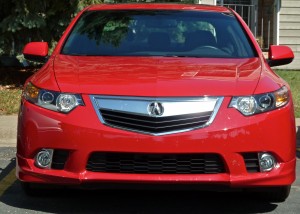
Where its larger siblings, the RL and TL, have undergone curious styling revisions, the TSX is now the most tastefully styled of the brand.
All of which brings us around to a bright red 2012 Acura TSX Special Edition, which, after a week-long road test, has become my favorite vehicle in the entire Acura line. It has none of the heft of the RL — or the current Accord, by the way — and it is unburdened by the over-reaching styling wanderings that took the TL from being the most beautiful car in Honda’s entire universe into some weird, buck-toothed wilderness, complete with chrome-splashed obnoxiousness. The TSX also has more of a sculptured sportiness and some of the luxury leanings of the new ILX.
The Special Edition is more than just the latest TSX. It is, as the name says, special.
The test car shows that Acura designers could, after all, restrain themselves from fastening that big, wide swath of chrome as a beak on all its models. That’s the drawback of a so-called “signature” feature; if it has universal appeal, great, but if it doesn’t, well, the TL’s appeal can disappear, and everybody gets the overdone overbite. The TSX has that widened upper lip on the grille, but it is less intrusive than the other Acuras, presumably because somebody at the home office tackled the radical designer before he could do similar damage.
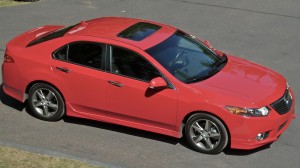
The Special Edition TSX 2.4-liter 4 has 201 horsepower to be guided by a 6-speed manual transmission.
While styling is subjective, I like the subtle contours of the TSX, but its best feature is what’s inside and under the skin.
The 2.4-liter 4-cylinder engine, with 16 valves and dual overhead cams, with i-VTEC variable valve timing control — which set Honda apart from less-high-tech rivals back in 1990 — and with a smooth-as-silk 6-speed manual transmission, brings the TSX fully to life as a sports sedan of the highest order.
We will find out by September of 2012 if all the new Accord rumors are true, but the most prominent one remains the addition of a new engine — a 2.4 with DOHC refined with direct injection, which should help fuel efficiency and performance, and supposedly will deliver 181 horsepower. The new Accord also is supposed to get a CVT, continuously variable transmission.
Yes, direct injection would be great on the 2.4, but until then, the TSX has the same engine without direct injection, but it has been refined to put out 201 horsepower. Hmmm…less refinement and more horsepower?.
The test TSX had a sticker price of $32,310, which includes Special Edition features such as a full underbody sound and aero kit, exclusive Special Edition seats, exclusive Special Edition lighting, with badges to show that it’s the Special Edition, and aluminum pedal plates. The intriguing thing is that after adding up the included upgrades, which total $2,500 if you could buy them, the car instead gets a Special Edition discount of $1,500, which drops the price to $30,810.
A standard delivery charge of $885 afflicts both sticker prices, and while it zips the total price over $33,000, it pushes the Special Edition price only up to $31,695 — still less than the standard TSX without the upgrades. That, is a bargain.
Hyundai has generated a revolution of sorts by adding such details as direct injection to the dual overhead cams of its 2.4-liter 4-cylinder, reaching 200 horsepower. The new Accord coming out supposedly will have 181 horsepower. The TSX Special Edition’s 2.4 hits 201 horsepower, and that’s without direct injection.
The TSX handles with firm efficiency, too, and from the driver’s seat, everything falls into place. That includes the shift lever, which zips through the six gears with optimal smoothness, adding fun and sportiness to the 30-miles-per-gallon efficiency. As automatic and dual-clutch transmissions become more and more sophisticated, there are fewer and fewer stick shift models available. The TSX proves there is still a place for them, for those companies, and consumers, who still prefer the basic manual shifting. Especially this sort of manual shifting.
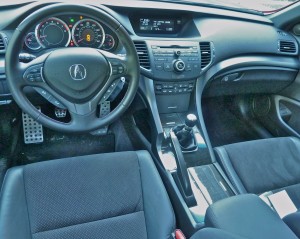
Controls are sporty and ergonomically sound, with non-glare black from its soft-toiuch dash down to the console.
I’m not sure all the buttons and controls on the center stack are necessary, and my iPhone was difficult to code into the hands-free system, but the center stack and console are refreshingly simple, even austere, because everything is a matte black, from the soft-touch texture of the dashboard to the button-filled center stack and on down to the console. Speedometer, tachometer and other instruments are simple and straightforward, and nowhere is there the bright, glare-catching accents of glossy silver trim that are so common on new cars, where a dash of flash seems more prominent than glare-free ergonomics..
In short, it’s the type of interior command post that gave Honda the reputation it richly deserved for ergonomic excellence. The same sort of ergonomic excellence BMW used to be able to boast about before iDrive, and now only seems to appear in base models.
My wife, Joan, who has become an expert at the benefits of coordinated energy for physical work with humans, was greatly taken by the TSX’s attributes. “I like the aero quality of the design, which makes the overall look pleasing,” said Joan. “The inner design is subtle and classy, and not flashy. The design inside and out made the car feel comfortable to look at, and it has all the energy of the old Hondas.”
I never thought of those particular attributes, but I couldn’t agree more. Maybe the new Accord, with its newly redone 2.4, will be as sporty, and it will offer a 6-speed stick shift along with its CVT automatic. But the Acura TSX is here, now, and it offers all of the attributes that established Honda as a high-tech leader and benchmark of inexpensive sporty sedans. If it is going to go away, the TSX Special Edition might be one to capture and hang on to.
Porsche 911 Carrera shines, top or not
By John Gilbert
As twins go, sometimes not being identical is preferable. That’s certainly the case of the Porsche 911 Carrera, where the Summer of 2012 brought a pair of Porsches virtually back to back for test drives. One was a sleek, dark green Carrera S Coupe, and the other was a sleek, dark blue Carrera Cabriolet convertible.
That’s not to say I would have turned down a second chance in an identical Coupe, but the opportunity to take pretty much the same car and drop the top was the perfect complement in Minnesota’s heat wave.
Both test cars had Porsche’s superb 3.8-liter flat-opposed 6-cylinder engine, rear mounted and attached to a rear-drive arrangement. So when you pop the trunk, both can elicit more than just the usual rubber-necking gaze, because the trunk is in the front, and passers-by always seem puzzled that there is only a quite-deep well under the front hood, with no engine up there.
Visually, the newest generation of 911 doesn’t look completely different, as 30 years hasn’t required major alteration from the original design. But if the visual impact of a Porsche 911 has remained true, so has the audible sensation, which is at least as recognizable. Turn the key in the 911 and you don’t get a rumble, or a roar — you get an unmistakable snarl. Tap the gas pedal, and the snarl sounds more urgent, more seriously businesslike. Driving the car is an extension of that wonderful sound.
If you’re a casual driver wanting to just go from Point A to Point B, drive something else. If you enjoy driving, and you’re willing to pay attention to the requirements of driving, the Porsche will make you a better driver, and it will immediately convince you of the advantages of devoting full attention to driving a car from Stuttgart. There are no cupholders. And frankly, even in this era of constant rehydration, you probably won’t miss them. There is a new and impressive audio system in the car, but if you start driving without it, you might forget to turn it on. While the car turns you on.
Both the Coupe and Cabriolet ride on the new 991 series for 2013, with an elongated wheelbase, so both earn similar but slight gains in spaciousness and lack of harshness. The biggest difference between the two cars is obvious. In the Cabriolet, you hit a switch on the console, either while at rest or rolling slowly, and the top unlatches from the front and retreats — with efficient quickness — under a raised rear cover, up and locked to down and airy in about eight seconds. Same with going back up. I never really timed it, although there is a timing device in the car as well, but if you’re two-thirds of the way through a red light when you realize it’s drizzling, you can still hit the switch and close the top, tightly, before green. Putting it down is even better, but both put on a mini-show that other drivers seem to marvel at, or at least enjoy. Read more


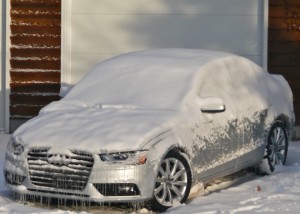
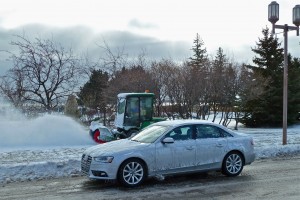
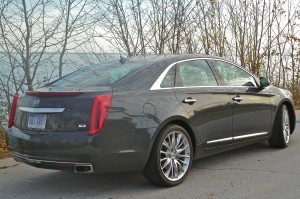
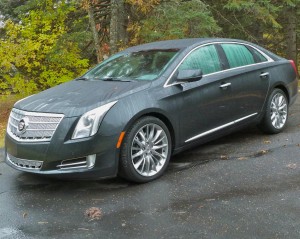
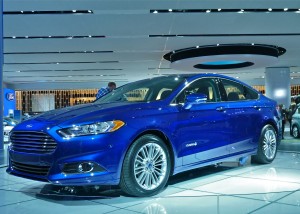
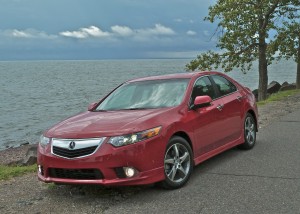
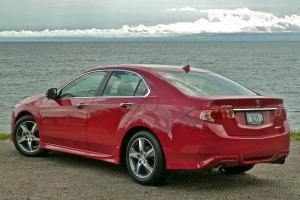
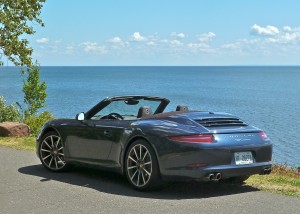
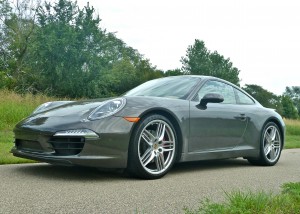
 John Gilbert is a lifetime Minnesotan and career journalist, specializing in cars and sports during and since spending 30 years at the Minneapolis Tribune, now the Star Tribune. More recently, he has continued translating the high-tech world of autos and sharing his passionate insights as a freelance writer/photographer/broadcaster. A member of the prestigious North American Car and Truck of the Year jury since 1993. John can be heard Monday-Friday from 9-11am on 610 KDAL(www.kdal610.com) on the "John Gilbert Show," and writes a column in the Duluth Reader.
John Gilbert is a lifetime Minnesotan and career journalist, specializing in cars and sports during and since spending 30 years at the Minneapolis Tribune, now the Star Tribune. More recently, he has continued translating the high-tech world of autos and sharing his passionate insights as a freelance writer/photographer/broadcaster. A member of the prestigious North American Car and Truck of the Year jury since 1993. John can be heard Monday-Friday from 9-11am on 610 KDAL(www.kdal610.com) on the "John Gilbert Show," and writes a column in the Duluth Reader.